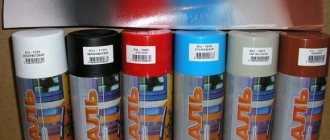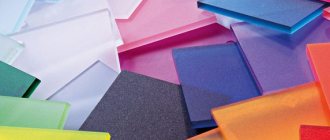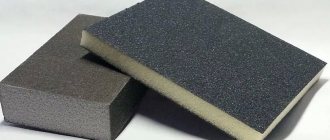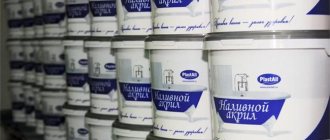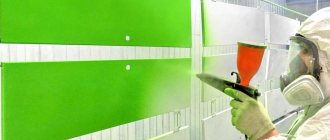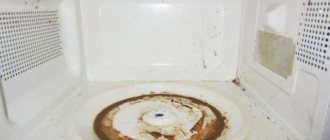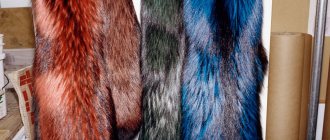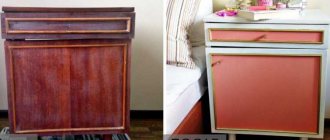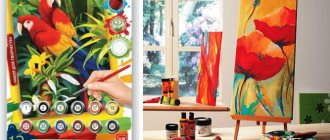Painting a glass surface can give a new look to the material and help change the interior of your home; you can paint a variety of glass, but you need to understand that the process is not as easy as when working with other substrates. This is explained by the smoothness of the surface, which is difficult for paint and varnish products to adhere to. How to paint glass correctly will be discussed in more detail below.
What glass products can be painted?
Painting glass can be used in different situations. Designers like to use such options, but you can apply the technique yourself, and then you will be able to create a unique product. Options when glass painting may be relevant:
- By adding to the overall interior, you can get a unified design style;
- When you need to quickly finish doors between rooms or entrances;
- Painting glass structures to make them look better and more attractive;
- Painted glass can complement cabinets, tables and other furniture items, and is suitable for working with mirrors;
- It is used to create accessories from this material; in this case, the process involves small work that requires special precision.
Painting glass can be used in different situations.
How to paint glass
The technology for painting glass is simple, but it requires special care when performing the work, since the paint may lie unevenly or begin to peel off. In addition, all work with glass must be carried out as carefully as possible to prevent cracking of the glass.
To paint glass, you will need either cans of paint or tools such as brushes, rollers, and foam rubber.
- The first thing to do before the painting procedure is to thoroughly degrease the surface. To do this, wash the glass product with soapy water. Rinse off the soap alternately with cold and hot water. Dry the surface using paper towels. For degreasing, you can use ready-made degreasing compounds for glass. After degreasing, do not touch the surface with your hands.
- Check the thickness of the paint. If it is too thick, thin it with varnish. The ideal consistency of paint is similar to liquid sour cream. The paint is applied in a thin, almost transparent layer.
- Place the glass on a flat horizontal surface. In this case, there will be no smudges or streaks left when painting.
- The most convenient way to paint glass is with spray paint. Paint sprayed this way goes on smoothly. Use spray cans for large surfaces.
- Before applying paint, cover with masking tape all areas that need to remain unpainted. The paint is sprayed from a distance of 30 cm. The pattern can be formed not only using tape, but also using a stencil, which must be firmly fixed to the surface before applying the paint to avoid displacement and smearing of the pattern.
- It is better to peel off the adhesive tape after the product has completely dried. This will make the boundaries of the drawing clearer.
- At the end of the work, you can coat the product with a transparent varnish, which will create an additional layer of protection for the applied coating.
Properties of painted glass
Painting the glass surface can be used for decorative purposes or for additional protection of the material. The paint gives a beautiful design to the material, highlighting the base, giving it a better look.
Dark shades can dim the lighting and reduce the amount of light entering through windows. In terms of protection, the fire-resistant property can be increased if glass is painted in the oven.
Painting the glass surface can be used for decorative purposes or for additional protection of the material.
Features of choosing a shade
If you need to obtain colored glass, you should take into account the fact that due to the opaque structure, the color rendition will differ significantly. Therefore, you must first check the special shade matching table, and only then go to the store to purchase the material.
Painting glass according to RAL greatly simplifies the task. In total, there are 213 types of tones in the table, so you can easily choose the right option. Not only the color itself is indicated there, but also a marking by which you can choose the paint on the display.
Glass paint has a special structure that makes it thicker and sometimes almost gel-like. This will make it much easier to work with vertical surfaces, since there will be no drips left.
Some types of materials require special processing after application. This may be subsequent opening with water-repellent varnish or drying with a hair dryer. The choice of high-quality consumables guarantees excellent results and no problems with operation. Therefore, you should always pay attention to the manufacturer.
What paints are suitable for working with glass?
The decision on how to paint the glass so that the paint does not wash off must be made after studying the types available for sale. At home, you can choose the following types of paints for this work: acrylic, polyurethane, silicate, and certain types in the form of felt-tip pens, etc. Each has its own excellent characteristics, and you should definitely take them into account when choosing.
Each paint has its own excellent characteristics, and you should definitely take them into account when choosing.
Acrylic paints for glass surfaces
Acrylic paints can be used for painting on glass. They are distinguished by a high degree of adhesion; when the drying stage is completed, a film-like coating remains on the material; they are well suited for smooth surfaces. The layer will be opaque.
Acrylic paints have a high degree of adhesion.
Silicate based paints
Paints with a silicate base. In this case, the composition itself contains elements of glass that is supposed to be painted. After complete drying, liquid glass creates a new glass coating. Similar dyes are produced in different shades, you can choose the right option for yourself.
Now it is possible to use pigments to obtain the desired color; multi-colored options are used. They withstand exposure to ultraviolet radiation and last for many years without changing their properties.
In addition, it is considered a heat-resistant paint for glass; this requires high-temperature exposure, which makes it difficult for household use. Usually chosen by professional craftsmen, in the industrial sector, where suitable equipment is available.
After complete drying, liquid glass creates a new glass coating.
Special stained glass paints
As the name suggests, they are necessary for creating stained glass windows. They help create subtle elements on the surface that are combined into a single composition.
Sometimes you can find information online about the possibility of applying alkyd-based paint to the base, but this paint and varnish material does not adhere well to glass and has low adhesion. There is also a rapid loss of brightness.
Stained glass paints help create subtle elements on the surface that are combined into a single composition.
Fast drying polyurethane dyes
Enamel with a polyurethane base is quick-drying; after drying, a film coating is formed. They are distinguished by a high level of water resistance; when used, it is possible to mix different shades to obtain the desired color. There is also a clear type of polyurethane paint that requires the addition of dye to create the desired tone for painting.
The surface will remain transparent, but the desired shade will be obtained.
Paints can be aerosol. It is more convenient to distribute the composition over the surface using an aerosol if painting will not be used, but a simple painting of the base is required.
It is more convenient to distribute the composition over the surface using an aerosol if painting is not used.
Ink, felt-tip pens, markers
When you need to draw small images or carry out complex painting, you can use paints for painting on glass in the form of felt-tip pens or markers. This form allows you to do this conveniently. They are manufactured to work not only with glass surfaces, but also with ceramic bases. They can, if necessary, be removed from the base, for this reason they are often chosen before decorating products for various events.
When you need to draw small images or carry out complex painting, you can use paints for painting on glass in the form of felt-tip pens or markers.
There are also special mascaras. For this purpose, carcasses are created that have a high level of adhesion to a smooth base. They allow you to create clear boundaries of the pattern with your own hands; rapidographs are suitable for glass. They are a container from which the liquid composition comes out in different thicknesses; for a full-fledged design, you will need to use different sized options.
They allow you to create clear boundaries of the pattern with your own hands; rapidographs are suitable for glass.
Painting tools
Glass painting is done using paints and varnishes that adhere well to the smooth and even surface of the product. If you choose the wrong composition, this can lead to further peeling or fading of the color. To paint glass at home, you can use ready-made paints or make them yourself.
Ready-made compositions are as follows:
The acrylic look adheres securely to the glass and looks like a matte film once all the work is completed. The advantages are that this glass paint does not change color and does not fade when exposed to direct sunlight. After drying, the glass becomes opaque.
The polyurethane type is very flexible. The main advantage is its fast hardening time. These compositions can be transformed into a different color using tinting, according to the proposed color palette. Modern manufacturers offer a huge number of shades. Glass painted with polyurethane compounds will be transparent.
Oil paints are intended only for the matte surface of the original product. A prerequisite is to dilute them with varnish. This gives the material durability and abrasion resistance. They can be washed using detergents. Such compositions do not tolerate high temperatures.
Glass coloring technology
Painting technology, if followed throughout the entire process, will result in a high-quality result that will also last a long time. Coloring is not so complicated, so you can do it at home to transform household items. A preparatory stage must be carried out in order to obtain an even layer, as well as to improve the adhesion of materials, otherwise the paint will flow down the glass.
If you follow the painting technology, you will get a high-quality result that will also last for a long time.
Surface preparation
It is necessary to prepare the base itself. The glass surface is well cleaned, using soap and water to remove all existing dirt. The solution will be washed off one by one, first using warm water, then cold. The order should be exactly like this. Follow the steps below step by step:
- It is necessary to degrease the surface; acetone or another available solvent is suitable for this;
- Stains on glass are wiped with a soft cloth;
- Those areas that do not need to be painted must be protected from paint; masking tape is suitable for this; it can be easily removed from any surface. Removal is carried out only after the paint has completely dried.
The glass surface is well cleaned, using soap and water to remove all existing dirt.
Tools and operating procedure
Rollers and brushes can be used for work, but the best result is obtained when painting with a spray gun or using paints in spray cans. If felt-tip pens are selected, then you do not need to purchase an additional tool.
You will also need a clean rag, degreaser, and dye. After preparation, proceed directly to staining.
The best result is obtained when painting with a spray gun, or using paints in spray cans.
How to consolidate the result
Painting can be done using different methods. There is an option to completely immerse the products in paint; you will need a container of suitable size. This option is suitable for working with small items. Can also be used:
- The roller allows you to quickly process large surfaces;
- Brushes are suitable for small areas and help paint hard-to-reach areas if the glass is textured;
- The sprayer allows you to quickly paint, the layer will be smooth and beautiful.
You can beautifully decorate glasses, vases and other interior items at home by creating drawings on them. The secret to a long-lasting result lies in the subsequent application of a fixative. The choice depends on the chemistry of the composition that was used for coloring, taking into account that such substances can be harmful and not all can be used for food products.
You can beautifully decorate glasses, vases and other interior items at home by creating drawings on them.
Existing options:
- If film inks are selected for painting, the image is drawn on a plastic file for application. When the layer dries, it is removed and you can transfer it to the glass, the design is glued. However, such a pattern cannot be washed, for this reason it will have to be removed each time;
- Stained glass dyes are fixed with a special varnish, which is intended for these products. Apply the product in a thin layer so that it is not noticeable afterward. It is advisable to purchase paint and varnish of the same brand;
- If you need to fix heat-resistant paint, then an oven is suitable. The painted object is placed on the oven rack, and the required degrees are set according to the manufacturer's instructions. After the required time has elapsed, the oven is turned off and the product processed using the heat-resistant method is waited to cool down. In the future it will be possible to apply varnish;
- In the absence of suitable compositions, in some cases you can fix the result with hairspray, clear nail polish, or acrylic nail gel.
Stained glass dyes are fixed with a special varnish, which is intended for these products.
How to paint correctly
To paint and do it correctly, you will need to become familiar with the technology of the process in question. There are no complex elements in it if you follow the recommendations. You will need to prepare the tool involved, work on cleaning the surface in order to begin painting it. This is interesting: stained glass painting.
Surface preparation
The glass must be washed with soapy water and washed off with cold and warm water. First, wash off with warm, cold water (this is important). Degreasing is carried out, for which purified acetone is used, however, other coloring compounds relevant to the process are also suitable. The stains remaining on the surface will be removed with a dry cloth; the edges and individual transitions, they are not painted, can be easily protected with masking tape. When the work is completed, it can be easily removed from the surface, the painted product will still look good.
Applying paint
Coloring is performed in several ways:
- Dipping - for this you need to completely lower the product into a bath of coloring material and carefully and delicately remove it. Excess composition will drain off, leaving only a thin film of the coloring composition on the surface.
- Roller - among similar options, this is a simple method when the master rolls the paint with a roller several times, which allows you to create a continuous coating.
- With brushes - it is used when the task is to apply relatively small colored spots to the surface and fill limited spaces. Large surfaces are difficult to paint with conventional brushes, as local unpainted areas may appear.
- Spraying - will quickly paint a large panel, for which a standard spray gun is used. The result is formed in a short time; a transparent film is formed on the surface, which can completely change its appearance.
How to make stained glass on glass at home
Preparation for stained glass technology is standard. The image itself is first applied along the borders with a special varnish; it serves as a barrier against paint spreading. For this reason, when making a detail in the drawing, you should not interrupt the line. After finishing the work, the result is fixed with varnish.
The image itself is first applied along the borders with a special varnish; it serves as a barrier against paint spreading.
The article described how to paint glass correctly so that it acquires a more interesting structure. There are many options for suitable paints on the market; the composition should be chosen taking into account the operating conditions. The painting process is simple, you can do it yourself.
Do-it-yourself coloring
Masters who have been working in this field of art for a long time will help you figure out how to paint glass without spending a lot of money on it.
The main stage is the initial preparation of the surface before applying paints and varnishes. It must be degreased using alcohol or acetone.
To paint glass with your own hands with high quality, you need the room temperature to be no more than 18 degrees.
The glass must be in a perfect horizontal position. This will allow you to monitor the quality of the work performed and reduce the occurrence of smudges.
The paint is applied to the glass canvas in a thin layer. Tools for this can be:
- brush;
- roller;
- sprayer (spray gun).
Which tool to choose depends on personal convenience and surface area. For small glass, it is recommended to choose a brush, and for large pieces, for high-quality work, it is better to use a sprayer.
Drying usually takes place at temperatures above 20 degrees, but below 80. Paint of different compositions dries differently, generally the drying time is three days.
For high-quality work, it is necessary to choose only proven materials from good manufacturers and with a normal shelf life. You need to monitor every stage and movement while working independently. The sight of glass painted with your own hands will not leave anyone indifferent and will attract the eye like a magnet. Moreover, there is a huge selection of coloring materials on the modern market.
Coloring technology allows designers to come up with and bring to life unique and interesting ideas. Thanks to their versatility, plain glass or glass with patterns will find their place in absolutely any room.
How and with what to paint glass (2 videos)
Which stained glass paints are best to choose?
If you want to paint on glass, the artist is faced with the question of choosing the right composition. When deciding what paint to use on glass surfaces, you should be guided by the purpose of the stained glass window.
Lacquer stained glass paints are best used by professional artists who are engaged in the design of large areas. The quality and color range of coloring materials makes it possible to use them on glass, furnished and fabric surfaces.
Lacquer enamel is great when painting requires different techniques.
Amateur and children's tasks regarding painting glass and ceramic surfaces can be performed with water-based paints. Such paint and varnish products are suitable for temporary surface decoration with subsequent rinsing, as well as decor and design of vases, plates, and other items.
On the market you can find a wide range of stained glass paints, among which the following brands have proven themselves to be the best:
- Lefranc&Bourgeois is a French paint and varnish product presented on the market in an assortment of 22 shades. The material is sold in 50 ml containers. The enamel has a solvent base, so after application the surface becomes smooth and glossy.
- Pebeo is sold in 4 series for painting walls.
- Marabu is a transparent, homogeneous composition with good quality. It does not require fixing or baking. The products are sold in 15 ml containers and are available at an affordable price.
For specialists in stained glass art, we offer kits that contain everything you need for painting on glass:
- the basis;
- paints;
- brushes;
- color scheme;
- sparkles and rhinestones.
Features of applying stained glass paint
A master who does not know how to use stained glass paints should remember several important points.
First of all, you will need to buy the necessary tools, including small brushes with hard bristles. Some people find it more convenient to draw on glass with a sponge. You can remove excess stains with a solvent before the drawing begins to dry. Inexperienced craftsmen are better off using non-firing compounds. Contour compositions are considered the best option; with their help, you can achieve preservation of the outlines of the pattern and painting style.
Before you start using stained glass paint at home, you will need to make a choice of paints for the design and the style of stained glass design. According to experts, it is better to make a stencil or sketches in advance. After applying the stencil to the glass, it is advisable to outline its boundaries with felt-tip pens or markers.
Coloring
You need to work with stained glass paints in a special way. Need to buy:
- Set of glass coloring agents;
- Contours for glass bases;
- Stencils (or you can make them yourself);
- Ethyl;
- Cotton sticks;
- Needle (toothpicks).
Before you start creating a drawing, you need to select it. You can take a ready-made template and simply copy it.
This coloring procedure takes place in several stages, which follow a strict sequence.
Before applying the dye, the glass must be wiped with a degreaser. If you have the ability to draw, then the drawing can be applied using a marker. Or you can fix the template on the inside and redraw it on the outside as if using a carbon copy.
The main lines of the drawing are outlined, but you need to draw it carefully and not break the lines. Then wait until it is completely dry, this time is written in the instructions.
Coloring agents for glass are applied in droplets, and then distributed over the design using a brush, trying to create a thick and uniform layer of coating. If there are any defects, they should be removed immediately with a cotton swab, and not wait until the drawing dries.
When all parts of the design are painted with one shade, the tool must be washed well, dried, and only then begin to paint with a different tone.
Air bubbles may appear in the layer of such paints and varnishes, which must be removed using something sharp (a needle or a toothpick).
To make the drawing dry faster, you can use a hair dryer.
How to paint with acrylic paint
Before you start working with this type of paintwork material, the base should also be wiped with a degreaser, and then draw the pattern yourself or use a template.
Glass paints can only be painted onto a design that has outlined lines, but acrylic-based paints can be used without an outlined design.
If you don’t select the outline, then it will look like a painting, and if you select the outline, then it will look like a stained glass image.
If kitchen products were decorated in this way, then after they have completely dried, the coating should be painted with a special protective varnish that is resistant to heat. This way the product will last longer and the patterns will remain rich and beautiful for a long time.
It is important to note that acrylic-based paints, which are also heat-resistant, dry in a short period of time, but in order for them to be stable, they must be baked in the oven.
Using spray products
These types of coloring agents are used to color glass products, but professionals can also use them to decorate small objects. This can be done even if you don’t have any special skills, but simply using templates or tape.
At special points, different types of products are sold in cans: oil-based, acrylic-based, latex-based, heat-resistant, and so on.
Often the means for drawing stained glass patterns or for decorating glass products are acrylic.
There is also the production of special materials in cans for working with different utensils, and they are resistant to heat.
The advantages of these types of coloring agents for glass products:
- Ready to use;
- Even places that are hard to reach are painted;
- High level of grip;
- Long shelf life, while the original qualities do not change;
- No need to buy tools;
- Do not fade or wear off;
- Wide selection of shades;
- Dries quickly.
But besides such advantages, such substances also have disadvantages:
- Do not dilute the composition;
- Hard to work;
- For a stencil, in any case, you need to finish drawing patterns that are too small - this increases the consumption of expensive material;
- You cannot mix different tones;
- You need to buy personal protective equipment.
When using paints and varnishes in cans, you must follow the rules specified in the instructions so that there are no streaks or smudges on the surface.
If the coloring procedure will be carried out outdoors, then it is better to choose warm weather and without wind.
The top sealing layer should be made using a clear acrylic-based varnish.

